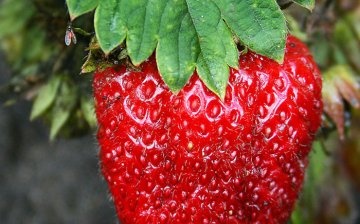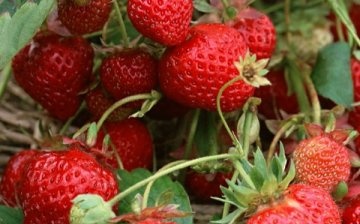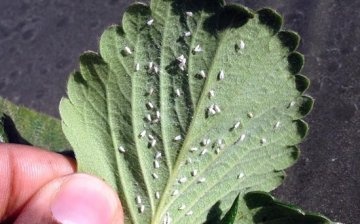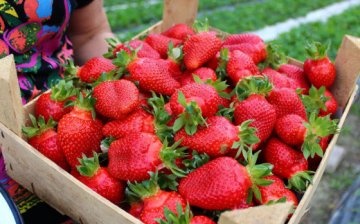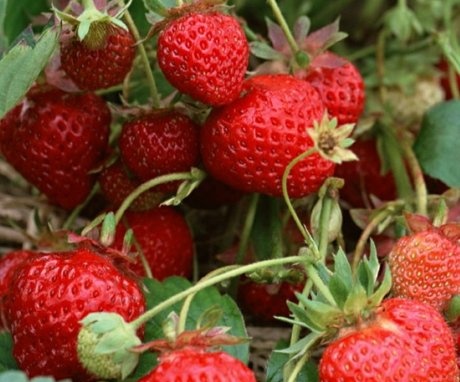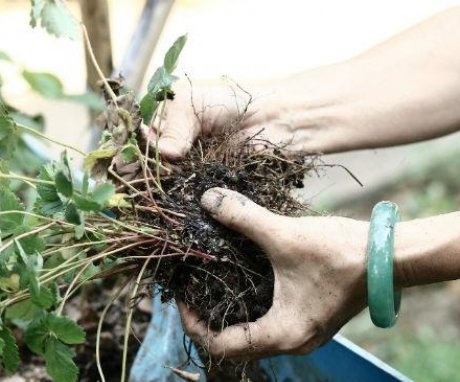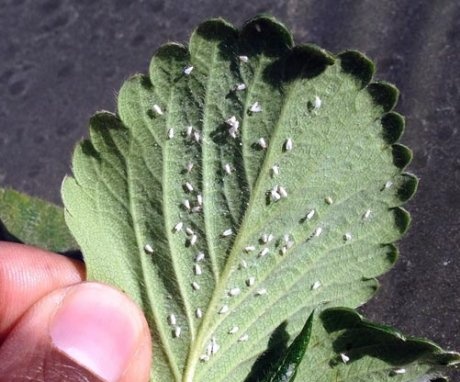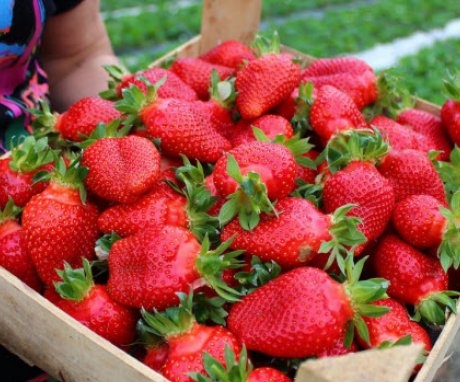Strawberries "Queen Elizabeth": description, agricultural technology and reviews
Garden strawberries are one of the favorite delicacies that you can grow on your backyard. The strawberry variety "Queen Elizabeth" was bred specifically for the Russian climate and has long won the love of gardeners.
Content:
- Description of the strawberry variety
- Growing conditions
- Strawberry care
- Reproduction methods
- Pest control
- Reviews of the strawberry "Queen Elizabeth"
Description of the strawberry variety
Strawberry variety "Queen Elizabeth" is resistant to drought and frost, and is also capable of producing an impressive harvest on almost any soil.
The berries are large, have a rich scarlet color with a glossy surface and a honey flavor.
Up to 2 kg of berries can be removed from one bush, each weighing 50-65 grams. The crop is excellently stored and transported over long distances. Strawberry can yield up to three times per season. This usually occurs in early June and July, and then at the end of August.
Growing conditions
Basic landing rules strawberries:
- Strawberries "Queen Elizabeth" can be planted at any time of the sowing season, but you need to be sure that there is no frost. It is preferable to choose the end of July or the beginning of August for planting. If you plant strawberries in spring, then you need to cut off all the buds that appear so that the bush will bear fruit well next year.
- The planting site should be bright and sunny, as strawberries do not tolerate shade. You should not plant strawberries in the lowlands, the site should be flat and closed from drafts.
- The ideal option for strawberries is loamy or sandy soil. It is important that the soil is not overdried and waterlogged. You should not plant strawberries on a site where the groundwater level is less than 80 cm from the earth's surface.
- It is good to plant strawberries in the area where they used to grow carrot, cucumbers, garlic or onion... Use of soil after roses and lilies.
How to make a strawberry bed correctly:
- The plot for the garden bed must be dug up, choosing stones, weeds and other debris, as well as breaking clods of earth.
- The garden bed can be fertilized with manure or compost in a volume of 8-10 kg per square meter.
- Soil acidity should be neutral. If the soil is oxidized, then use dolomite flour, or ash.
- The day before disembarking, it is necessary to sprinkle the bed with sand, then loosen it.
- Strawberry bushes should be planted 25 cm apart.
- For bushes, you need to cut the roots up to 7 cm in length, and then dip them in a mixture of clay and manure. Next, the bushes are placed in holes 20 cm deep and sprinkled with earth. The main kidney should be 2 cm above the ground surface.
- After planting, the soil is spilled with warm water, at the rate of one liter per bush.
- Then the soil is crushed and leveled. The bush should sit tightly in the ground.
Strawberry care
Basic rules for caring for strawberries:
- Strawberries love moist soil, so it is optimal to maintain constant soil moisture at a depth of 3-5 cm. watering every 2 or 3 days. Before flowering, it is advisable to use the method drip irrigation, or pour water between the rows of plantings.Drops should not fall on inflorescences and fruits. The water for irrigation should not be too cold. After watering, it is advisable to loosen the soil.
- Feeding strawberries is best organic fertilizers... These include: manure, a mixture of fermented herbs, spraying with ash infusion, kvass from rye bread, milk whey. Of course, you can use and mineral fertilizers, but it is worth considering that this will affect the quality of the crop.
How to properly prepare strawberries for wintering:
- After the last harvest strawberries watered abundantly for the last time this season.
- Dry foliage and weeds are removed from the garden.
- Sick and withering leaves are cut from the bushes.
- Mounds of soil are formed around the bush, the root collars should be covered with soil.
- The soil is mulched with peat, humus and needles, 5 cm thick.
- At the first frost, the bushes are covered with air-permeable material.
Reproduction methods
There are three ways to propagate strawberries: using seeds, using a mustache and dividing a bush.
Propagation using seeds is carried out as follows:
- This is the most difficult and time-consuming method of reproduction, since only half of 10 seeds will sprout. In order to obtain seed, take the largest and ripe berries, cut off the upper strips and allow them to dry in the sun, and then separate the seeds. It is important that the berries are healthy and not overripe.
- Optimal planting time seed - end of January or beginning of February.
- Three days before planting, the seeds are poured with rain or melt water, which must be changed after 12 hours.
- The planting container should be 15 cm deep. It is filled with soil (fertile substrate) and moistened with a spray bottle.
- Seeds are planted at a distance of 3 cm, pressing 5 mm into the ground.
- The container is covered with foil and placed under phytolamps... The room temperature should be 20-22 degrees. Once a day, the film is removed for 5-7 minutes in order to ventilate the planting.
- The first shoots appear in two weeks.
- With the appearance of the first leaf, the duration of airing is increased, and after the first month of planting, they begin to be taken out into the open air.
- Seedlings are ready for planting in open ground in 4 months.
Reproduction using a mustache is done as follows:
- Choose the strongest lower mustache.
- With the help of a wire, they attach the mustache to the ground for a month and a half.
- After rooting, they are dug up and transplanted to the prepared site.
Reproduction dividing the bush carried out as follows:
- Reproduction is carried out in spring or autumn.
- The strawberry bush is removed from the soil and the roots are examined for damage.
- If there is no damage, then the roots are divided with a sterile knife.
- The cut parts are treated with ash or activated carbon.
- Plants are ready to be planted in the selected area.
Pest control
Despite the resistance of strawberries to harsh climatic conditions, it is still susceptible to some diseases and pests. The most common problems that gardeners face:
- Spider mite and strawberry mite. Symptoms: with a spider mite, the leaf has beige-brown spots, and then curls and dries up. The presence of a cobweb is also an obvious symptom. With a strawberry mite, the leaves curl and the berries dry out. Treatment: spraying with decoctions of onion and garlic peels, washing the bushes with soapy water, using insecticides, collecting and disposing of fallen leaves from the planting site.
- Strawberry weevil. Symptoms: the buds turn black, dry out, and then fall off. The larvae feed on fruits. Treatment: spraying with infusions of tobacco, mustard or pepper using soap, collection and disposal of fallen leaves, manual collection of pests, use of insecticides, adjacent planting Luke and garlic.
- Strawberry nematoda. Symptoms: deformed foliage that breaks off very easily. The fruits are also uneven and small.Whitish swellings are present on the roots. Treatment: adjacent plantings marigolds and marigold, spraying with brine, using insecticides, fumigating with a sulfur stick.
- Slugs. Symptoms: holes in berries and leaves. Treatment: beer traps, mulching with needles, ash, eggshells, adjacent spicy plants, use of insecticides.
- Gray rot. Symptoms: gray blotch with black blotches. Treatment: dusting the area with ash, collecting and disposing of fallen and diseased foliage, using fungicides.
- White spot. Symptoms: brown-bordered spots. Treatment: spraying with iodine solution, use of fungicides, collection and disposal of diseased plants.
Reviews of the strawberry "Queen Elizabeth"
Strawberry variety "Queen Elizabeth" is one of the best varieties. The advantages of the variety are such characteristic features as frost resistance, high yield, size and taste of berries, as well as unpretentious cultivation.
Despite the forced fight against pests and diseases, gardeners speak flatteringly about Queen Elizabeth strawberries. After all, this variety has much more advantages than disadvantages.
More information can be found in the video:




